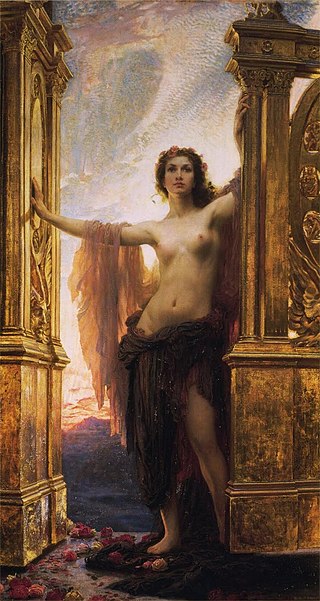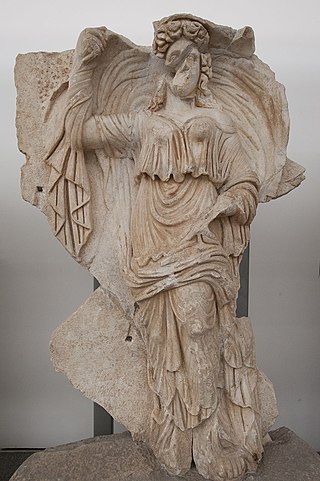
In ancient Greek mythology and religion, Eos is the goddess and personification of the dawn, who rose each morning from her home at the edge of the river Oceanus to deliver light and disperse the night. In Greek tradition and poetry, she is characterized as a goddess with a great sexual appetite, who took numerous human lovers for her own satisfaction and bore them several children. Like her Roman counterpart Aurora and Rigvedic Ushas, Eos continues the name of an earlier Indo-European dawn goddess, Hausos. Eos, or her earlier Proto-Indo-European (PIE) ancestor, also shares several elements with the love goddess Aphrodite, perhaps signifying Eos's influence on her or otherwise a common origin for the two goddesses. In surviving tradition, Aphrodite is the culprit behind Eos' numerous love affairs, having cursed the goddess with insatiable lust for mortal men.

In Greek mythology, Io was one of the mortal lovers of Zeus. An Argive princess, she was an ancestor of many kings and heroes, such as Perseus, Cadmus, Heracles, Minos, Lynceus, Cepheus, and Danaus. The astronomer Simon Marius named a moon of Jupiter after Io in 1614.

In Greek mythology, Hemera was the personification of day. According to Hesiod, she was the daughter of Erebus (Darkness) and Nyx (Night), and the sister of Aether. Though separate entities in Hesiod's Theogony, Hemera and Eos (Dawn) were often identified with each other.

New World orioles are a group of birds in the genus Icterus of the blackbird family. Unrelated to Old World orioles of the family Oriolidae, they are strikingly similar in size, diet, behavior, and strongly contrasting plumage. As a result, the two have been given the same vernacular name.
A barbarism is a nonstandard word, expression or pronunciation in a language, particularly one regarded as an error in morphology, while a solecism is an error in syntax. The label was originally applied to mixing Ancient Greek or Latin with other languages, but expanded to indicate any inappropriate words or expressions in classical studies and eventually to any language considered unpolished or rude. The term is used mainly for the written language.

A Greek–English Lexicon, often referred to as Liddell & Scott or Liddell–Scott–Jones (LSJ), is a standard lexicographical work of the Ancient Greek language originally edited by Henry George Liddell, Robert Scott, Henry Stuart Jones, and Roderick McKenzie and published in 1843 by the Oxford University Press.

The mina is an ancient Near Eastern unit of weight for silver or gold, equivalent to approximately 1.25 pounds (0.57 kg), which was divided into 60 shekels. The mina, like the shekel, eventually also became a unit of currency.

Notodontidae is a family of moths with approximately 3,800 known species. The family was described by James Francis Stephens in 1829. Moths of this family are found in all parts of the world, but they are most concentrated in tropical areas, especially in the New World.

The ilium is the uppermost and largest region of the coxal bone, and appears in most vertebrates including mammals and birds, but not bony fish. All reptiles have an ilium except snakes, although some snake species have a tiny bone which is considered to be an ilium.
Zieria lasiocaulis, commonly known as Willi Willi zieria, is a rare species of flowering plant in the citrus family Rutaceae and is endemic to New South Wales. It is a tall shrub or small tree with three-part leaves and inconspicuous white flowers, found only at high altitudes in areas with a high rainfall.

In Greek and Roman mythology, Aura is a minor wind goddess, whose name means "breeze". The plural form, Aurae is sometimes found to describe a group of breeze nymphs. According to the late antiquity writer Nonnus, Aura is the daughter of the Titan Lelantos and the mother, by Dionysus, of Iacchus, a minor deity connected with the Eleusinian mysteries, while Quintus Smyrnaeus makes the Aurae daughters of Boreas, the god of the north wind. Aurae was the title of a play by the Athenian comic poet Metagenes, who was contemporary with Aristophanes, Phrynichus, and Plato.
Aciculopoda is an extinct prawn which existed in what is now Oklahoma approximately 360 million years ago. It was described in 2010 on the basis of a single fossil from Oklahoma. The single species, Aciculopoda mapesi, was named by Rodney Feldmann and Carrie Schweitzer in honour of Royal Mapes, a paleontologist who discovered the type specimen. It is only the third unambiguous fossil decapod from before the Mesozoic.

Urocitellus is a genus of ground squirrels. They were previously believed to belong to the much larger genus Spermophilus, but DNA sequencing of the cytochrome b gene showed that this group was paraphyletic to the prairie dogs and marmots, and could therefore no longer be retained as a single genus. As a result, Urocitellus is now considered as a genus in its own right.
Argentala argoptera is a moth of the family Notodontidae first described by James S. Miller in 2008. It is found along the western slope of the Ecuadorian Andes in cloud forest habitats at elevations between 1,200 and 2,600 meters.
Largocephalosaurus is an extinct genus of basal saurosphargid, a marine reptile known from the Middle Triassic Guanling Formation of Yunnan and Guizhou Provinces, southwestern China. It contains a type species, Largocephalosaurus polycarpon, and a second species L. qianensis.
Brusqeulia atrograpta is a species of moth of the family Tortricidae. It is found in Minas Gerais, Brazil.
Zieria cephalophila is a plant in the citrus family Rutaceae and is only found on a single, isolated mountain in Queensland. It is a compact shrub with wiry branches, warty, three-part leaves and one to three white flowers, each with four petals and four stamens, in leaf axils.
Thelymitra cyanapicata, commonly called the dark-tipped sun orchid, is a species of orchid that is endemic to South Australia. It has a single fleshy, linear, channelled leaf and up to three small blue or pale purplish to maroon flowers with a dark purplish blue top of the anther.

In Greek mythology, Cephalus is a Aeolian prince, the son of Deion/Deioneos, ruler of Phocis, and Diomede, and grandson of Aeolus. He was one of the lovers of the dawn goddess Eos.
In Greek mythology Smilax was the name of a nymph who was in love with Crocus and was turned into the plant bearing her name. Ancient sources with information about her and her tale are few and far between.









